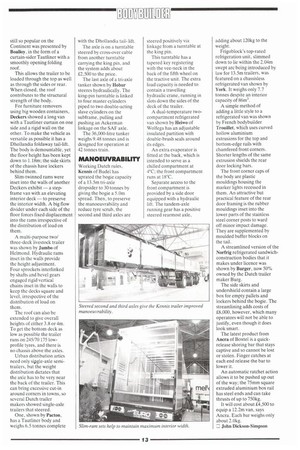DEMOUNTABLES DOMINATE DUTCH DEMONSTRATION
Page 152

Page 153

If you've noticed an error in this article please click here to report it so we can fix it.
A few years ago Dutch bodybuilders were saying swap bodies had a 3% market share. Today it's nearer 20%, proving that demountables are definitely in vogue.
• The big Amsterdam commercial vehicle show amounted to a huge exercise by its exhibitors to make the best possible job of the restrictions on dimensions and weights imposed by EC regulations.
Within the Benelux countries the width limit is 2.6m irrespective of body type — weights are virtually a matter of how many axles you can cram in. On heights and lengths there is a 2% tolerance, and a one-metre bodyoverhang allowance beyond that. So, for instance, on the question of drawbar-train length that seems to be causing such self-inflicted anguish in Brussels, the enlightened Dutch already have 19m drawbar-outfits carrying twinned 8.2m bodies without ultra-close towing. In the Dutch view, the EC proposal to limit bodies to 7.45m is out of step with reality.
The search for load volume is as frantic as ever, judging from the Amsterdam show. The combination on everyone's lips was 3m of interior height within an overall height of 4m. That means low-profile tyres, air suspension, low chassis, slim-neck semi-trailers and shallow sub-frames on bodies. Interest in doubledeck bodies is also strong.
With the gross weights being generous there is no severe pressure for light construction for Dutch transport, but there is for cross-border European transport, of which the Dutch now claim more than 35%. They want loads that gross, say, 42 tonnes in Holland to be carried within 40 tonnes on international routes; impossible at present, but some Dutch operators are now buying aluminium trailers and asking for lighter bodies so that they can claw back at least a tonne. However extra weight and cost is having to be incurred using positively steered axles on trailers to meet EC turning radii of 12.5 and 5.3m.
The other big themes to engulf Dutch transport are quick turnround and rapid response to the political pressure to encourage inter-modal traffic. A few years ago, Dutch bodybuilders at Amsterdam were saying, swap bodies had a 3% market slice — now it is nearer 20%.
SPECIAL HANDLING
A surge of interest in swap bodies — treating them as intermodal containers with folding legs — seems to be creating a need for special handling equipment at freight terminals. One of the snags found by the Dutch in loading swap bodies is that if they are left on their legs they can tip up if lifted by fork trucks.
Apart from that, the swap bodies built to the German DIN standard have very long legs that put the floor heights out of step with loading banks. So Estepe of Heesch has devised a skeletal frame with cable-folded legs at the corners to provide a stable base for swap bodies at loading areas.
Lifting bridges front and rear on the Terberg shunter raise the skeletal frame and its legs are swung down automatically by a horizontal ram. This has a tongue that engages a central sliding bar connected by cables to the legs. So swap bodies are always fully supported and can be deposited at loading banks at just the right height to allow fork trucks to drive in and out.
An adjustable-length skeletal semi-trailer able to carry containers of between 6.1 and 13.7m long was shown by Netam Fruehauf. The front chassis has a shallow swan neck so that its rear can slot into a sliding running gear section. With low-profile tyres on the tri-axle bogie, its overhead cross-beams stand just 1.2m high. The leading axle is liftable so that when running in its short form the semi-trailer does not suffer excessive scrub. A handwound rack-and-pinion provides the length adjustment.
An alternative to the dropside tilt bodies that are still so popular on the Continent was presented by BoaIloy, in the form of a curtain-sider Tautliner with a smoothly opening folding roof.
This allows the trailer to be loaded through the top as well as through the sides or rear. When closed, the roof contributes to the structural strength of the body.
For furniture removers using big wooden containers, Deckers showed a long van with a Tautliner curtain on one side and a rigid wall on the other. To make the vehicle as versatile as possible it has a Dhollandia foldaway tail-lift. The body is demountable, yet the floor height has been kept down to 1.18m; the side skirts of the chassis have lockers behind them.
Slim-twinned rams were inset into the walls of another Deckers exhibit — a stepframe van with an elevating interior deck — to preserve the interior width. A big flow divider under each side of the floor forces fixed displacement into the rams irrespective of the distribution of load on them.
A multi-purpose two/ three-deck livestock trailer was shown by Jumbo of Helmond. Hydraulic rams inset in the walls provide the height adjustment. Four sprockets interlinked by shafts and bevel gears engaged rigid vertical chains inset in the walls to keep the decks square and level, irrespective of the distribution of load on them.
The roof can also be extended to give overall heights of either 3.8 or 4m. To get the bottom deck as low as possible the trailer runs on 245/70 175 lowprofile tyres, and there is no chassis above the axles.
Urban distribution artics need only single-axle semitrailers, but the weight distribution dictates that the axle has to be very near the back of the trailer. This can bring excessive cut-in around corners in towns, so several Dutch trailer makers showed single-axle trailers that steered.
One, shown by Pacton, has a Tautliner body and weighs 6.5 tonnes complete with the Dhollandia taillift.
The axle is on a turntable steered by cross-over cable from another turntable carrying the king pin, and the system adds about £2,500 to the price.
The last axle of a tri-axle tanker shown by Hobur steeres hydraulically. The king-pin turntable is linked to four master cylinders piped to two double-acting slave cylinders on the subframe, pulling and pushing an Ackerman linkage on the SAF axle.
The 36,000-litre tanker weighs 9.48 tonnes and is designed for operation at 42 tonnes train.
MANOEUVRABILITY
Working Dutch rules. Kennis of Budel has uprated the bogie capacity of a 13.5m tri-axle dropsider to 30 tonnes by giving the bogie a 5.0m spread. Then, to preserve the manoeuvrability and reduce tyre scrub, the second and third axles are steered positively via linkage from a turntable at the king pin.
This turntable has a tapered key registering with the vee-neck in the back of the fifth wheel on the tractive unit. The extra load capacity is needed to contain a travelling hydraulic crane, running in slots down the sides of the deck of the trailer.
A dual-temperature twocompartment refrigerated van shown by Heiwo of Wolfega has an adjustable insulated partition with double-brush seals around its edges.
An extra evaporator is fitted at the back, which is intended to serve as a chilled compartment at 4°C; the front compartment runs at 180C.
Separate access to the front compartment is provided by a side door equipped with a hydraulic lift. The tandem-axle running gear has a positive steered rearmost axle, adding about 120kg to the weight.
Frigoblock's top-rated refrigeration unit, slimmed down to lie within the 2.04m swept arc being introduced by law for 13.5m trailers, was featured on a chassisless refrigerated van shown by York. It weighs only 7.7 tonnes despite an interior capacity of 86m3.
A simple method of adding a little style to a refrigerated van was shown by French bodybuilder Trouthet, which uses curved hollow aluminium extrusions for the top and bottom-edge rails with chamfered front corners. Shorter lengths of the same extrusion shields the rear door locking bars.
The front corner caps of the body are plastic mouldings housing the marker lights recessed in them. An attractive but practical feature of the rear door framing is the rubber mouldings inset into the lower parts of the stainless steel corner posts to ward off minor impact damage. They are supplemented by moulded buffer blocks on the tail.
A streamlined version of the Norfrig refrigerated sandwichconstruction bodies that it makes under licence was shown by Burger, now 50% owned by the Dutch trailer maker Burg.
The side skirts and undershield contain a large box for empty pallets and lockers behind the bogie. The streamlining adds costs of £8,000, however, which many operators will not be able to justify, even though it does look smart.
The latest product from Ancra of Boxtel is a quickrelease shoring bar that stays captive and so cannot be lost or stolen. Finger catches at each end release the bar to lower it.
An automatic ratchet action allows it to be pushed up out of the way; the 75mm square extruded aluminium box rail has steel ends and can take thrusts of up to 750kg.
It will cost about £4,500 to equip a 12.2m van, says Ancra. Each bar weighs only about 2.0kg.
2 John Dickson-Simpson
















































































































































































